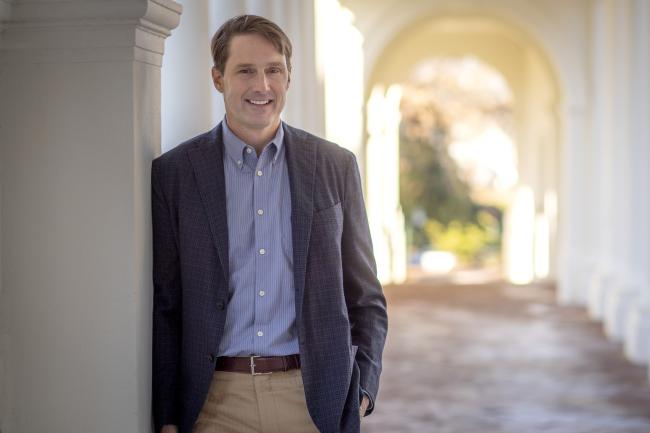Teresa Sullivan
Teresa Sullivan served as the eighth president of the University of Virginia from 2010 to 2018. She came to UVA from the University of MIchigan where she was the provost and executive vice president for academic affairs.

Teresa Sullivan was no stranger to big data by the early 2010s. She worked with Census data — perhaps the crown jewel of big data sets — while completing her doctoral dissertation in the early 1970s at the University of Chicago.
“It was very time consuming, clunky compared to what you do today,” she recalled of the tapes she pored over in order to extract what she needed. It was tedious work, but she developed a knack for it, even catching an error that the Census Bureau wound up correcting. Decades later she would write a short book about the controversies surrounding the 2020 Census.
The 1970 Census may have been Sullivan’s first experience with big data, but it would hardly be her last.
In 1985, Sullivan, then a sociology professor at the University of Texas, was having lunch with two law professors, who were bemoaning the fact that it was difficult to assess whether recently enacted bankruptcy reforms were effective. Sullivan had an idea — look at the data.
She took the two professors — one of whom was future U.S. Sen. Elizabeth Warren — to the federal courthouse in San Antonio where they pulled a random sample of 150 bankruptcy cases and then coded them, a process, Sullivan recalled, that was much more cumbersome in the mid-1980s than it would be today.
Their hard work, though, yielded some compelling results, and they would eventually receive funding from the National Science Foundation and expand their study to other states. Their findings that bankruptcy laws were often not working as intended met some resistance. But the data ultimately won out.
“A lot of people said we were just wrong,” Sullivan recalled. “And there ensued a lot of controversy and some follow-up research. And our work passed from completely wrong to conventional wisdom in about five years.”
Sullivan would hold a variety of senior administrative roles at the University of Texas and the University of Texas System until 2006, when she was named provost and vice president for academic affairs at the University of Michigan.
After four years in Ann Arbor, Sullivan, in 2010, was tapped to become the University of Virginia’s eighth president. She would be the first female to hold the office and would serve for eight years. Her ascension to the top leadership post at UVA would prove fortuitous for data science at UVA.
Rick Horwitz and company would also enlist another important ally in John Simon, who took over as the University’s provost in September 2011. Momentum was building.
To gauge interest and bring together people with experience working with big data, plans were made to convene a summit focused on the concept that was developing.
The first Big Data Summit, a seminal event for data science at UVA, was held on May 9, 2012. The half-day gathering featured short presentations followed by panel discussions around the following themes: data producers; infrastructure issues and challenges; analytics and algorithms; and needs, opportunities, challenges, and next steps.
The overarching theme, though, was a clarion call to attendees to think creatively and without a preconceived notion of where this idea was headed: “Data, data everywhere without a plan in sight.”
By any measure, the summit was a success.
“It was just absolutely amazing,” said Horwitz. “It was beyond our expectations.”
“We were totally surprised,” said Don Brown of the interest and attendance, saying that they initially expected 60 to 80 faculty participants, not the 170 who attended from 32 departments.
“Far more than I anticipated,” Teresa Sullivan said.
The enthusiasm coming out of the first Big Data Summit, however, was marred, at least temporarily, by the forced resignation of Sullivan in June.
“It was devastating,” said Horwitz. After widespread protests, though, Sullivan was reinstated, and data science had its champion back in the president’s office.
In May 2013, a second Big Data Summit was held, with opening remarks from Brown, Sullivan, and Horwitz. The topics for this gathering showed the vast potential of data science to touch on a diverse range of disciplines and policies. Sessions focused on humanities, social sciences, and the arts; physical sciences and engineering; and biosciences and medicine.
There was no denying by the summer of 2013 that the time for big data at UVA had arrived; the next step was turning this vision into something concrete.
Sullivan asked Horwitz to present and promote the emerging concept around data science and a UVA institute at an early August retreat of UVA’s Board of Visitors. Their response was overwhelmingly positive, and they encouraged the group to move forward quickly with their plans.
At the same time that UVA leaders were organizing summits and making the case for an institute, alumni such as Jaffray Woodriff were independently advocating for the University to lead in data science.
Jaffray Woodriff’s passion for data began long before he ran a hedge fund. Like many, he was a baseball fan as a child, but unlike some, he was particularly enamored by the work of legendary, and pioneering, writer and statistician Bill James.
“I read as much as I could find of his writings, usually two or three times,” Woodriff said. “He was absolutely brilliant with data science and baseball statistics, yet even though he was publishing all of his work, he wasn’t even recognized as someone that knew anything at all about baseball.”
It wasn’t until decades later that Major League Baseball teams widely embraced the statistical tools James was championing in the 1970s. “This sort of highlights how slowly humanity adjusts to great ideas,” Woodriff said.
Woodriff studied finance at UVA, graduating in 1991. Even before enrolling he’d developed an interest in trading stocks and resolved that he would focus his studies on the goal of becoming a hedge fund manager. He attributes his success in trading stocks to his use of machine learning.
“Like Bill James was very early to apply data science to baseball statistics, I was very early to apply data science to trading stocks,” Woodriff said.
He would go on to found the Charlottesville-based firm Quantitative Investment Management in 2003, where he would continue to enjoy incredible success through his systematic use of machine learning in trading markets.
Another passion of Woodriff’s is squash, and he wanted UVA to field a team. But, Teresa Sullivan recalls, as with many aspects of higher education, there were resource limitations.
“I sat down with Jaffray and basically said, ‘Look, if this is what you want, you’re pretty much going to have to endow it because we’re just not going to have the resources in athletics to stretch it to another team,’” Sullivan says she told Woodriff.
Woodriff would end up supporting the establishment of men’s and women’s varsity squash teams and construction of the McArthur Squash Center.
“It’s certainly a world-class squash facility,” Woodriff said. “I’m very proud of that.”
“I think he was pleased not only that we were we able to do something new, but that we were able to do it on time, on budget, in a responsible way,” Sullivan said.
Woodriff’s support of new ventures at UVA was only just beginning. For years he had been advocating that UVA should lead in data science, even as conversations about “big data” and interdisciplinary collaboration were taking shape across the University. His independent efforts to champion data science at UVA would eventually align with the institution’s own momentum.
“I had always wanted UVA to be the leader in data science,” he said. “And I couldn’t really figure out a good way to make that happen.”
An invitation to a dinner hosted by Sullivan would provide the opportunity he’d been waiting for.
In 2012, a few moments occurred in quick succession as efforts at UVA to push big data to the forefront were ongoing.
A much larger, national spotlight began to shine on the issue. First, major national media outlets would take notice, including an in-depth look by The New York Times, which christened the era “The Age of Big Data.”
Then, the Obama administration put the weight of the White House behind the issue, unveiling the “Big Data Research and Development Initiative” in March 2012.
“In the same way that past Federal investments in information-technology R&D led to dramatic advances in supercomputing and the creation of the Internet, the initiative we are launching today promises to transform our ability to use Big Data for scientific discovery, environmental and biomedical research, education, and national security,” said John Holden, director of the White House Office of Science and Technology Policy, in a statement announcing the effort.
While these events helped galvanize outside interest, Sullivan notes that efforts at the University were well underway.
“We’ve been thinking along these lines already, so I don’t think we reacted particularly to the outside interest,” she said. “We had our own internal dynamic underway already.”
In fact, there were two internal dynamics. While Rick Horwitz and his group were developing their ideas, Sullivan was proceeding on a parallel path.
After arriving at UVA, she was invited to join the Business-Higher Education Forum, a group that convenes senior high education officials and CEOs to discuss trends. Not long after joining, she participated in a session on data science. She recalls CEOs describing how, increasingly, job candidates did not have the skills that were required, adding that they thought they would soon need to outsource positions due a lack of needed talent in the U.S. — a potentially “alarming” development, Sullivan recalled.
Around the same time, she met with Robert Groves, director of the U.S. Census Bureau, who told her that it was critically important that college graduates not just be data literate but also be able to work with very large datasets.
Sullivan would soon meet and begin talking with Horwitz: “We were both on the same track — we just didn’t know it,” Sullivan said.
Horwitz, Don Brown, and their colleagues no longer needed to worry about finding a champion in the president’s office for data science. “I was actually prepared to sell them,” Sullivan said.



